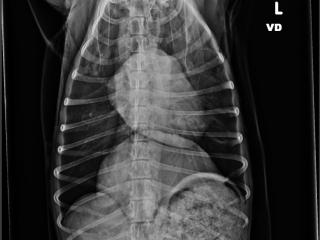
Digital Radiology
As technology leads us into the future and improves our lives, diagnostic imaging is no exception. Digital radiology gives our practice the ability to diagnose conditions almost on the spot. This allows us to treat conditions faster and more effectively.
What Radiology Used To Be Like
In the old days, a technician spent a considerable amount of time carefully positioning the X-ray machine and the pet to get just the right view of the area to be diagnosed. The X-ray films were then processed through a lab and sent back to our practice for viewing. A lightbox was necessary to view the films, and we had only the naked eye to examine them. If the image was poor or blurry, we retook the X-rays, and the whole process began again.
Digital Radiology Today
Using today’s most current digital radiography, our practice takes the x-ray image using advanced machinery which sends it directly to digital X-ray sensors for storage and display on a computer. There is no lag time and no waiting for films to process at a separate lab. This means that if the exposure is poor or if your pet moved a little bit, we can see the flaws immediately and retake the X-ray right then and there. We can also share the image digitally instead of sending large films out through the mail.
Like most digital images, our practice can easily enhance the digital X-ray image on the computer. We can zoom in, or change the contrast and brightness for better viewing. Plus a digital X-ray technology creates a much clearer and detailed image than traditional X-rays. Computer programs assist us in identifying and analyzing changes of an ongoing condition, which requires a series of images.
How We Use Digital Radiology For Your Pet
Our practice uses digital radiology both for dental purposes and for your pet’s whole body. Dental digital radiology allows us to view the internal anatomy of the teeth including the roots and surrounding bone. In the rest of your pet’s body, digital X-rays can help us identify a fractured bone, degeneration in a joint, or even foreign objects. An added bonus of digital radiology is the fact that it emits less radiation than traditional radiology.
Veterinary diagnostic imaging is used to discover internal disease or injury. VIDA Veterinary Care – Denver & VIDA Veterinary Care – Centennial employs advanced imaging technologies operated by board-certified veterinary radiologists, guaranteeing the highest quality of care for our patients.
Radiographs, or X-rays, use electromagnetic radiation directed towards the body to highlight objects within. They can detect abnormalities including skeletal fractures, soft tissue damage, foreign bodies and dental disease.
VIDA Veterinary Care – Denver & VIDA Veterinary Care – Centennial Radiology Services
- Radiographs
- Ultrasounds
- Computed Tomography (CT)
- Magnetic Resonance Images (MRI)
Orthopedic radiographs and contrast studies require the patient remain completely still to work correctly, necessitating sedation in most cases. Some specialized procedures may require anesthesia. The duration of sedation or anesthesia is usually short and patient recovery is swift. A board-certified anesthesiologist oversees all procedures.
Schedule an Appointment in Denver or Centennial Today!
To schedule a radiology consultation or appointment for your pet, call our Denver office at 303-757-5638 or our Centennial office at 303-843-7222, or fill out our online scheduling form.
Explore Our Complete List of Veterinary Services in Denver, CO & Centennial, CO
- Senior Cat Care
- Kitten Care
- Cat Vaccinations
- Cat Surgery
- Cat Spaying & Neutering
- Cat Nutrition
- Cat Microchipping
- Cat Laser Therapy
- Cat Laparoscopic Surgery
- Cat Lab Tests
- Cat Diagnostic Imaging
- Cat Dental
- Cat Cardiology
- Cat Cancer
- Anesthesia & Patient Monitoring
- Puppy Care
- Dog Lab Tests
- Heartworm Prevention
- Parasite Prevention
- Cancer Referrals
- Dentistry
- Wellness Care for Cats
- Wellness Care for Dogs
- Dog Laser Therapy
- Acupuncture
- Dog Spay & Neuter
- Dog Vaccinations
- Exotic and Avian Care
- Dog Dental Care
- Dog Nutrition
- Dog Surgery
- Dog Diagnostic Imaging
- Senior Dog Care
- Dog Microchipping
- Emergency Veterinary Care
